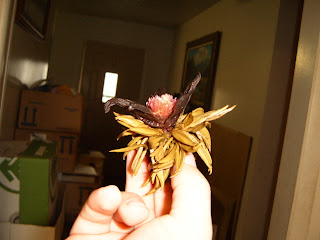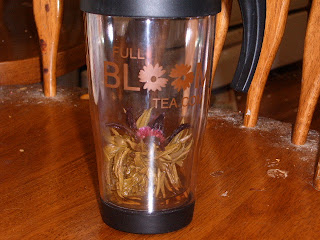A couple of weeks ago, I received an email from Mr. Kuperberg which stated that he'd come across this blog, had recently launched a new specialty tea company, and would like to send me some of his products to review complimentary if I'd like.
If any of you know me very well (and I'm not sure that you do), you'd know that I very rarely turn down the opportunity to try something new, very rarely turn down something that doesn't 
I promptly sent him my mailing information and awaited the arrival of what I thought perhaps two or three, but certainly no more than a half dozen samples of his products.

few days early!
I then set out, over the next few days, to sample some of these teas. In this review, you'll be hearing about the 14 ounce travel mug, although I assure you that a review covering the lovely class teapot will be up within the next couple of weeks. The very first bloom (which is called the friendship bloom) was utterly breathtaking - as if something magical were occurring right there in the mug. I set the water to boil, dropped the bloom in the travel mug, and when the water was boiling, poured it over the bloom. It was absolutely beautiful. Scarlet flower petals uncurled and expanded, and as they did, they slowly released a stream of scarlet color into the water. As the pips on the flower head begun to stand up and get more color, they, too, released streams of scarlet into the water, slowly trickling down. The tea leaves themselves - silver needle white tea leaves - also began to expand outwards, appearing as if they were the base of this lovely flower which was blooming right before my eyes. Floral scent was wafting up from the mug, causing my mood to life. I allowed the tea to bloom for about 5 minutes before I
It was absolutely beautiful. Scarlet flower petals uncurled and expanded, and as they did, they slowly released a stream of scarlet color into the water. As the pips on the flower head begun to stand up and get more color, they, too, released streams of scarlet into the water, slowly trickling down. The tea leaves themselves - silver needle white tea leaves - also began to expand outwards, appearing as if they were the base of this lovely flower which was blooming right before my eyes. Floral scent was wafting up from the mug, causing my mood to life. I allowed the tea to bloom for about 5 minutes before I  drank it.
drank it.The tea itself was absolutely delicious. Perhaps some of the best tea I've ever had. This is, no doubt, because it is white tea, which is prized above all teas for it's rareness and delicate flavour.
The tea was almost as good after the second brewing (you can brew each bloom 2-3 times), but I opted not to chance it for a third.
 After I had finished drinking the beverage, I took the bloom out of the mug, and was stumped at what to do next. The idea of throwing such a beautiful flower away was painful, but the idea of not being able to use the mug for the next time I wanted a bloom was even worse. I should have placed it in a clear glass and put it on display (yes, they really are that remarkable), but instead, I tenderly placed it in its final resting place.
After I had finished drinking the beverage, I took the bloom out of the mug, and was stumped at what to do next. The idea of throwing such a beautiful flower away was painful, but the idea of not being able to use the mug for the next time I wanted a bloom was even worse. I should have placed it in a clear glass and put it on display (yes, they really are that remarkable), but instead, I tenderly placed it in its final resting place. So, to review the entire experience here, I'd have to say that the most common element here is theatre and show. Everything through the whole process is show. The shipping box, the product packaging, the brewing of the beverage, and even the drinking of the beverage are all very visual experiences, and necessarily have a certain theatrical element to them. Everything about this is carefully planned out. IN fact, even the packaging took months to decide on - They wanted packaging that would brighten your day. And they got it.
So, to review the entire experience here, I'd have to say that the most common element here is theatre and show. Everything through the whole process is show. The shipping box, the product packaging, the brewing of the beverage, and even the drinking of the beverage are all very visual experiences, and necessarily have a certain theatrical element to them. Everything about this is carefully planned out. IN fact, even the packaging took months to decide on - They wanted packaging that would brighten your day. And they got it. 
Now, that being said, I think that most people would not find this an everyday tea. This is the sort of beverage that one might drink when entertaining company, or when celebrating something, or perhaps to give as a gift. Each bloom retails for about $3 a piece, and for the commuter teacup pictured here, the cost is $12. Not a huge cost, but not something most people could afford everyday. It also may be a bit over-elegant for the everyday, unless you're like me, and live on elegance whenever possible.
FullBloomTea.com now has a special offer available, in which you can obtain a free sample for just the cost of shipping ($2.) The sample includes one tea bloom. You can find the link at the top of their home page.
Also, new to their website is a list of all locations that retail their teas. If you are fortunate enough to have one of these in your area, you can skirt the shipping charges on their products by purchasing them at a retail store.
If you're a radio person, you might soon be hearing an advertisement for this company come over the air. These will be valentine-related advertisements. Tea blooms, much like roses, can be used to incite wonderful feelings on a special occasion, and can be used to let someone know that you love them and are thinking about them. Since these blooms have flowers as an integral part of them, what more appropriate gift might one give for valentine's day? "A flower to warm them from the inside out."
Well, that's a wrap for this entry. That's it for the year, and I look forward to having you all read my entries next year as well. I wish you a happy and prosperous 2007, and bid you adieu.
-Relznuk
